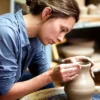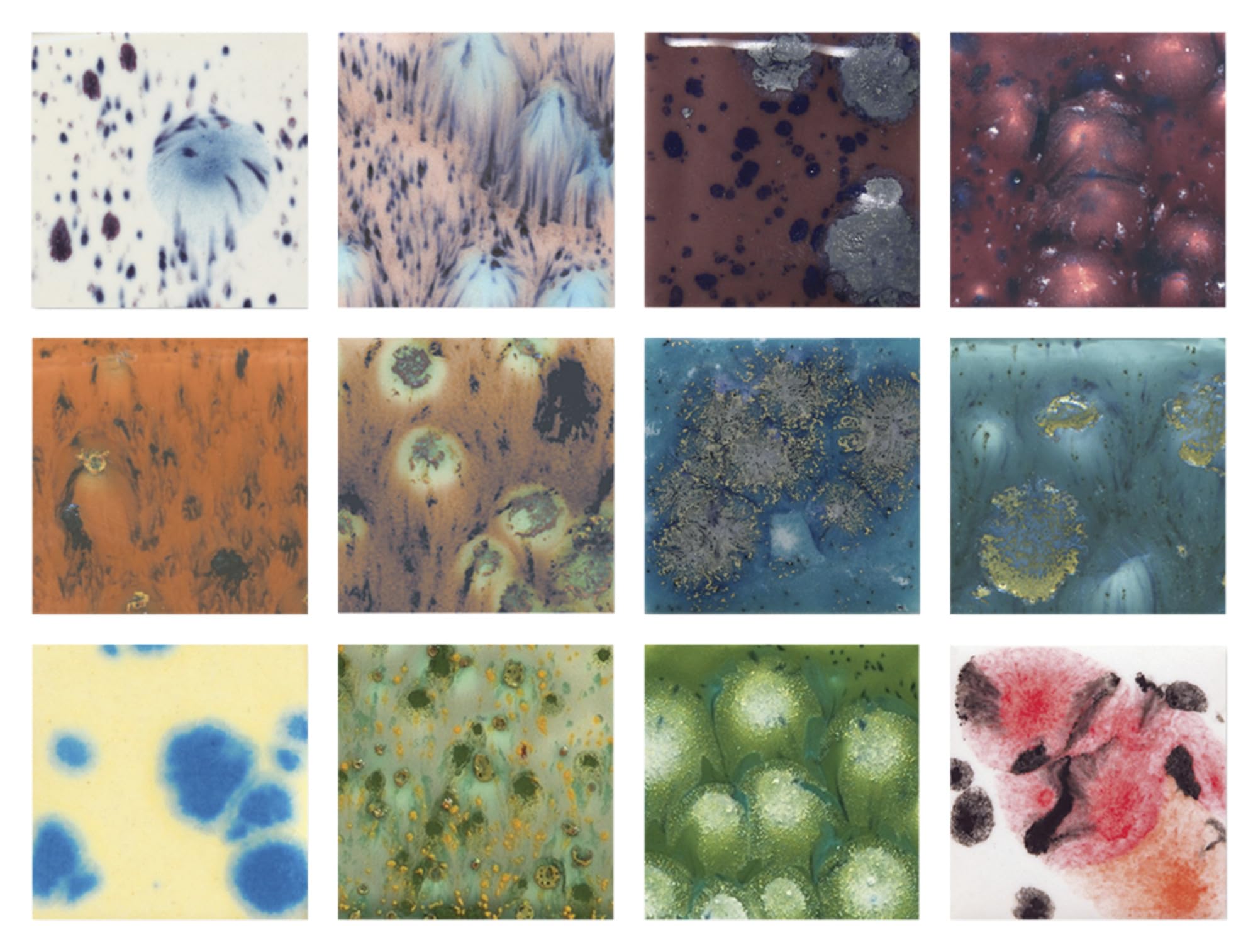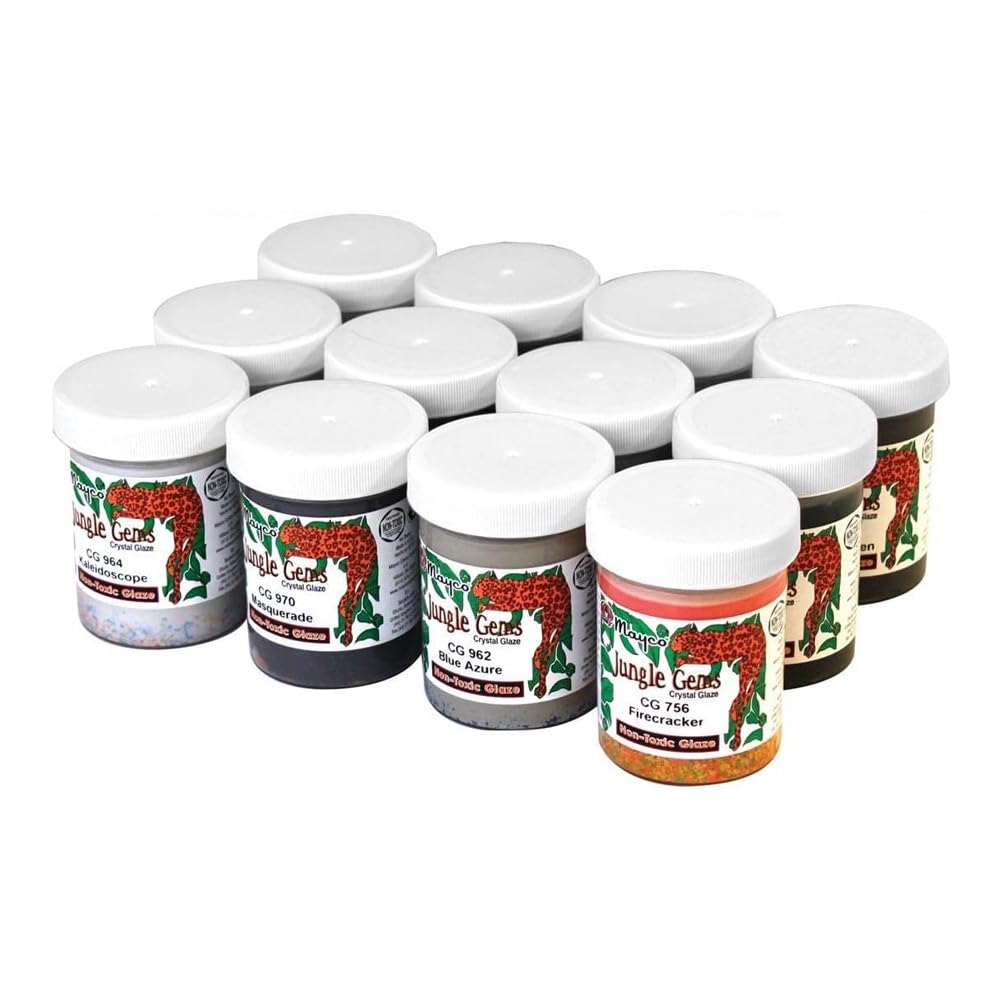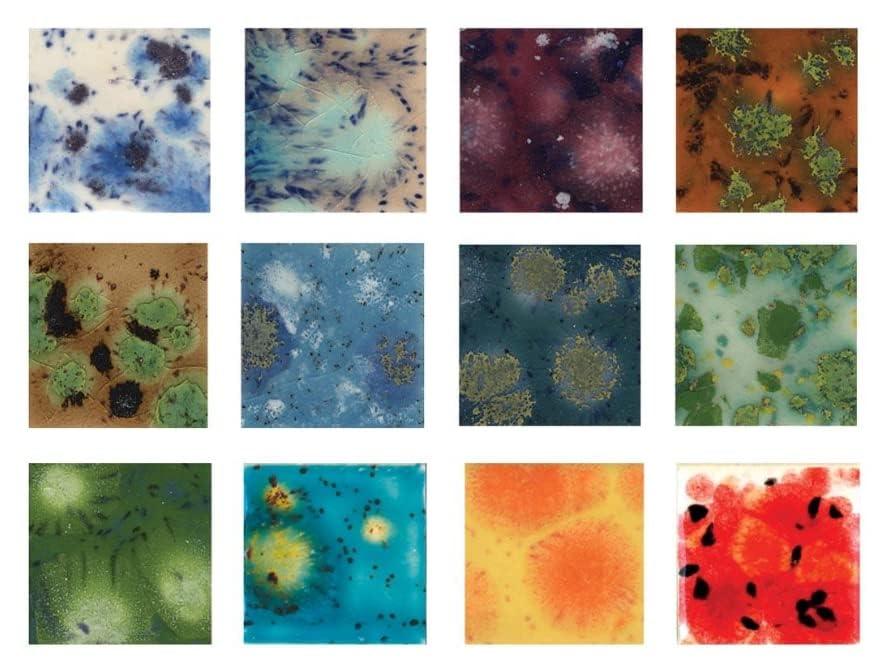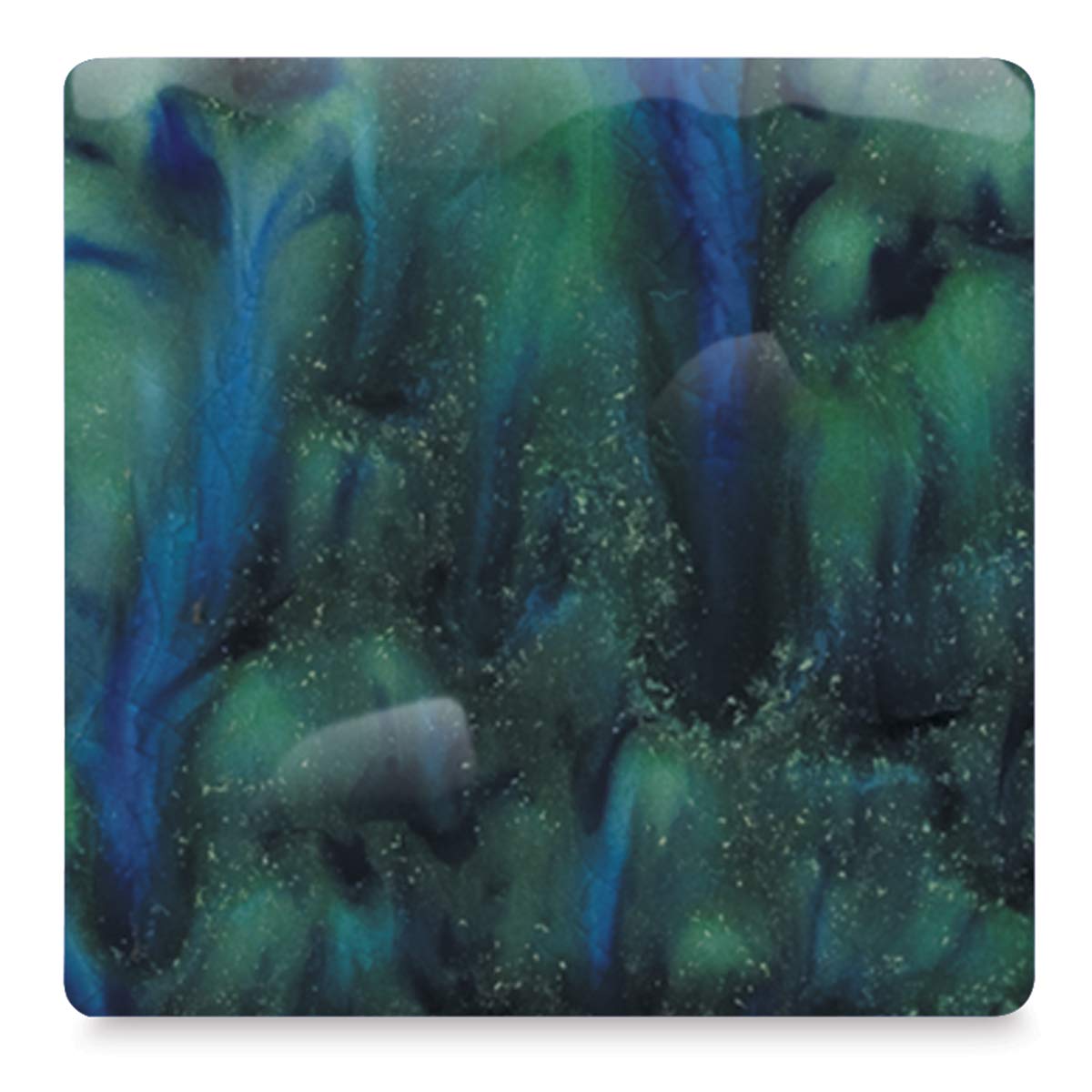Crystalline glazes offer a unique aesthetic to pottery that can transform a simple piece into a work of art.
These glazes create crystal-like formations on the surface of pottery, adding depth and allure.
Known for their dazzling patterns and vibrant colors, they are prized among both hobbyists and professionals who seek to push the aesthetic boundaries of their ceramic works.
When selecting crystal glazes, several factors should be considered to ensure the best results.
The type of glaze, its compatibility with the clay body, and the kiln’s firing range are critical aspects to pay attention to.
Many glazes may also have specific requirements for application and firing schedules, meaning the potter must be well-prepared for experimentation and adjustments.
Safety considerations, including ventilation and the glaze’s composition, are also crucial, as some glazes may contain materials that require careful handling.
The potential for creating truly unique pieces makes the selection of crystal glazes an exciting process.
With the right glaze and technique, even novice potters can experiment with creating beautiful and intricate designs.
Best Crystal Glazes for Pottery
We’ve curated a selection of the top crystal glazes to enhance your pottery projects.
These options are known for their vibrant colors and unique crystalline patterns, perfect for both beginners and seasoned artisans.
Explore our list to find the ideal glazes to elevate your ceramic creations.
Sax Crystal Magic Glazes
These glazes offer stunning, unique results, making them a must-have for creative pottery projects.
- Creates multicolored, intricate patterns with ease
- Ideal for both beginners and seasoned artists
- High-quality, non-toxic formula
- Not suitable for dinnerware
- May arrive with packaging issues
- Results can be unpredictable
We’ve recently tried out the Sax Crystal Magic Glazes, and they can truly transform any pottery piece with vibrant multicolored designs.
The variety in each application is incredible and offers endless creative opportunities.
Watching the crystals bloom during firing is both fascinating and satisfying, giving each piece a unique finish.
The set is perfect for art classes or individual projects, catering to a wide range of skill levels.
However, if you’re looking for something to use on dinnerware, this might not be the best choice due to its surface characteristics.
While the glazes provide beautiful results, each project comes with a bit of unpredictability, meaning you might not get exactly what you initially envisioned.
It’s worth noting that you should inspect the packaging upon arrival as we experienced a slight issue with one of the jars.
Mayco Jungle Gems Crystal Glaze Set
For those seeking unique and vibrant pottery, this set offers a delightful array of colors and effects that make each piece stand out.
- Produces unique, colorful effects on pottery
- Offers a wide range of vibrant colors
- Versatile firing range options
- Requires consistent stirring for best results
- Glazes may appear different on red clay
- Packaging might not be durable
These glazes allow us to create one-of-a-kind pieces with ease.
The spread and flow of the crystals as they “bloom” during firing is quite fascinating.
Each color offers something distinct, making every project an exciting experiment.
We were intrigued by the variety of colors, not to mention the beautiful effects they produce.
The ease at which the crystals create flowing patterns adds a dynamic touch to our pottery creations.
Using them on Cone 04 bisque provided the most interesting outcomes for us.
A bit of patience is required, as consistent stirring is necessary to keep the crystals evenly distributed.
While the results on red clay differed slightly, the fun of seeing the ultimate outcome was well worth it for us.
Mayco Crystalites Glaze Set
This set offers stunning colors and patterns perfect for creative ceramic projects.
- Brilliant color outcomes
- Versatile with other glazes
- Easy application process
- Not suitable for dinnerware
- Requires consistent stirring
- Potential shipping issues
We recently explored the Mayco Crystalites Glaze Set in our studio, and the results were genuinely impressive.
Each jar revealed vibrant hues and intricate patterns that transformed our pottery into pieces of art.
We appreciated the variety of twelve colors, each offering unique possibilities for our projects.
Pairing these glazes with other types truly elevates the artwork.
The colors are compatible with luster glazes, creating an even broader spectrum of color combinations.
Remembering to shake and stir the jars well ensures that the crystals spread evenly, producing the best results.
While our experience was positive, there are a few things to note.
These glazes shouldn’t be used on items intended for food use.
Additionally, some users reported issues with packaging during shipping, so it’s worth checking your order upon arrival.
Mayco Stoneware Crystal Glaze – Blue Hydrangea
For potters looking for a blend of usability and stunning results, Mayco Stoneware Crystal Glaze – Blue Hydrangea is a must-have.
- Consistent and user-friendly application
- Produces vibrant textures and finishes
- Stable across a range of cone temperatures
- Requires multiple coats for best results
- Dries slowly between layers
- Price may be high for the pint size
We recently tested the Mayco Stoneware Crystal Glaze in Blue Hydrangea, and its versatility left us quite impressed.
The rich hues and interesting specks that appear after firing bring a delightful finish to any pottery piece.
It layers beautifully, allowing for creativity in glaze combinations that can bring a unique touch to your work.
Applying this glaze was straightforward, even for beginners.
Its even consistency makes it easy to work with, though patience is required as it does need to dry thoroughly between coats.
We recommend applying at least three coats to truly see its potential, especially at Cone 6.
Whether you’re aiming for a delicate, rustic look or pushing the boundaries with artistic textures, these glazes provide plenty of options.
The colors developed beautifully after firing, living up to the promise of mimicking the gentle yet vibrant elegance of hydrangeas.
Mayco Jungle Gems – Blue Azure
This is a vibrant glaze that transforms ordinary pottery into mesmerizing works of art with its striking color and playful crystal effects.
- Impressive color transformation
- Suitable for multiple firing temperatures
- Creates unique patterns
- Requires careful layer application
- Results may vary depending on firing
- Can be unpredictable without proper technique
Our experience with the Mayco Jungle Gems Crystal Glaze – Blue Azure was quite fulfilling.
Each piece of pottery painted with this glaze took on a life of its own once it emerged from the kiln.
The dazzling splashes of blue and hints of green added a unique character to our creations.
It’s like painting with a bit of magic.
The glaze opens up a world of creative possibilities, especially if layered properly.
We found that using thick layers and incremental firing temperatures yielded the most mesmerizing results.
It’s remarkable how these small glass frits turn into stunning patterns and colors, adding depth to our projects in unexpected ways.
For those looking to experiment, it’s vital to approach it with patience and attention to detail.
While some results were slightly more transparent than we anticipated, the quality and aesthetic appeal still managed to impress us enough to continue experimenting with different techniques and applications.
Buying Guide
When selecting crystal glazes for pottery, several factors can help us make informed choices.
Ingredients and Composition:
Look for glazes with quality raw materials.
Purity matters – high-quality ingredients result in better luster and stability.
Temperature Range:
The firing temperature is crucial.
Choose glazes that match our kiln’s range to ensure compatibility and prevent defects.
Opacity and Finish:
Evaluate the finish: glossy or matte.
Consider opacity levels depending on the aesthetic we desire.
Visual Effects
Some glazes create vibrant colors, while others produce muted tones.
Understand what we want visually to select appropriate glazes.
Consistency
- Thick: May provide deep, pronounced crystals.
- Thin: Offers subtle, refined textures.
Application Method
Different techniques, like brushing, pouring, or spraying, influence how glazes perform.
Choose glazes that suit our preferred methods.
Table of Key Considerations
| Feature | Description |
|---|---|
| Ingredients | Ensure high-quality components |
| Temperature | Match with kiln specifications |
| Finish | Choose glossy or matte |
| Application | Select for brushing, pouring, etc. |
Testing Small Batches:
It’s wise to test small quantities first.
This lets us see the glaze’s result and make necessary adjustments before full application.
Safety:
Always check for any safety warnings.
Some glazes are better suited for non-functional pieces due to toxicity.
Frequently Asked Questions
We explore the facets of achieving crystal formations, techniques for application, and ideal firing temperatures for crystal glazes.
Our guidance includes firing recipes, crucial considerations for pottery jars, and the impact of glaze thickness on appearance.
How can one achieve crystal formations in pottery glazes?
To achieve crystal formations, focus on the cooling process.
You can manage this by controlling the cooling rate after firing.
Maintaining a slow cooling cycle allows the crystals to form and grow.
What are the best techniques for applying crystalline glazes to ceramics?
We recommend using a brush or pouring method to apply crystalline glazes.
These techniques allow you to manage the glaze thickness effectively.
Consistency in application ensures even crystal growth across the ceramic surface.
At what temperature should crystal glazes be fired to achieve optimal results?
Optimal results require firing at temperatures between 2150°F and 2300°F. This temperature range allows for proper glaze melting and crystal formation.
Always ensure a controlled cooling period after reaching these temperatures.
Can you provide some successful crystalline glaze recipes for cone 6 firing?
For cone 6 firing, you can use a basic glaze recipe involving zinc oxide and silica.
Tailoring the proportions of these ingredients allows you to achieve various crystal sizes and appearances.
What are the essential considerations when creating pottery jars with crystal glazes?
When working with pottery jars, you must consider the glaze thickness and application consistency.
Ensuring a uniform layer can help you avoid defects.
Additionally, proper venting during firing is crucial to prevent trapped air pockets.
How can the thickness of a crystalline glaze affect the final appearance of pottery?
The glaze’s thickness plays a crucial role in the final appearance.
Thicker layers tend to produce larger crystals.
However, we must find a balance, as too much thickness can lead to runniness and defects.

